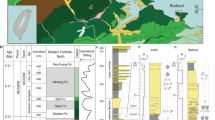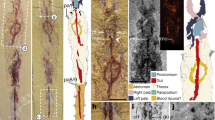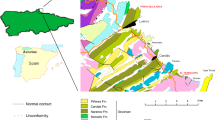Abstract
PSEUDOSCORPIONS (Class Arachnida; Order Pseudoscor-piones) represent a diverse and abundant group of small predatory arthropods1–4. Approximately 3,000 living species occupy habitats ranging from sea level to 5,000 metres elevation. Until now, the fossil record of the group extended back only 35 million years, to the Oligocene, where nearly 30 species, all in extant families, have been described from the Baltic Amber5. Addition pseudoscorpions have been described from the younger Dominican6 and Mexican7 ambers, and they too are all assignable to modern families. We now report the discovery of two pseudoscorpion specimens in Middle Devonian sediments near Gilboa, New York, USA. This find increases the documented age of the order more than 10-fold to ∼380 million years. Although the specimens cannot be assigned with certainty to any extant superfamily, their excellent state of preservation allows us to make numerous inferences concerning behaviour and ecology, such as silk use, grooming and tactile behaviour. The presence of certain well preserved structures indicates that Devonian pseudoscorpions were predatory, as are their modern counterparts. Our discovery provides further evidence that fully terrestrial arthropods coexisted with primitive vascular plants during the Middle Devonian.
This is a preview of subscription content, access via your institution
Access options
Subscribe to this journal
Receive 51 print issues and online access
$199.00 per year
only $3.90 per issue
Buy this article
- Purchase on Springer Link
- Instant access to full article PDF
Prices may be subject to local taxes which are calculated during checkout
Similar content being viewed by others
References
Chamberlin, J. C. Stanford Univ. Publ. Biol. Sci. 7, 1–283 (1931).
Beier, M. Pseudoskorpionidea I und II, Das Tierreich 57 u. 58 (de Gruyter, Berlin, 1932).
Weygoldt, P. The Biology of Pseudoscorpions (Harvard University Press, Cambridge, 1969).
Muchmore, W. B. in Synopsis and Classification of Living Organisms Vol. 2 (ed. Parker, S.) 96–102 (McGraw-Hill, New York, 1982).
Schawaller, W. Stuttgarter Beitr. Naturk. Series B 42, 1–22 (1978).
Schawaller, W. Stuttgarter Beitr. Naturk. Series B 57, 1–20 (1980).
Schawaller, W. Stuttgarter Beitr. Naturk. Series B 85, 1–9 (1982).
Shear, W. et al. Science 224, 492–494 (1984).
Shear, W., Selden, P., Rolfe, W., Bonamo, P. & Grierson, J. Amer. Mus. Novitates 2901, 1–74 (1987).
Shear, W. & Bonamo, P. Am. Mus. Novitates 2927, 1–30 (1988).
Norton, R., Bonamo, P., Grierson, J. & Shear, W. J. Paleont. 262, 259–269 (1987).
Shear, W., Palmer, J., Coddington, J. & Bonamo, P. Science (in the press).
Weygoldt, P. & Paulus, H. Z. Zool. Syst. Evolut.-Forsch. 17, 177–200 (1979).
Riessland, A. & Görner, P. in Neurobiology of Arachnids (ed. Barth, F.) 138–161 (Springer, Berlin, 1985).
Petrunkevitch, A. Trans. Connecticut Acad. Arts Sci. 18, 1–137 (1913).
Kethley, J., Norton, R., Bonamo, P. & Shear, W. Micropalaeontology (in the press).
Author information
Authors and Affiliations
Rights and permissions
About this article
Cite this article
Shear, W., Schawaller, W. & Bonamo, P. Record of Palaeozoic pseudoscorpions. Nature 341, 527–529 (1989). https://doi.org/10.1038/341527a0
Received:
Accepted:
Issue Date:
DOI: https://doi.org/10.1038/341527a0
This article is cited by
-
The first fossils of the most basal pseudoscorpion family (Arachnida: Pseudoscorpiones: Pseudotyrannochthoniidae): evidence for major biogeographical shifts in the European paleofauna
PalZ (2022)
-
Pseudoscorpion mitochondria show rearranged genes and genome-wide reductions of RNA gene sizes and inferred structures, yet typical nucleotide composition bias
BMC Evolutionary Biology (2012)
-
Calibrating the chelicerate clock: a paleontological reply to Jeyaprakash and Hoy
Experimental and Applied Acarology (2009)
-
Ecological and evolutionary pathways of social behavior in Pseudoscorpions (Arachnida: Pseudoscorpiones)
acta ethologica (2009)
-
An enigmatic, solifuge-like fossil arachnid from the Lower Carboniferous of Kamienna Göra (Intra-Sudetic Basin), Poland
Paläontologische Zeitschrift (2003)
Comments
By submitting a comment you agree to abide by our Terms and Community Guidelines. If you find something abusive or that does not comply with our terms or guidelines please flag it as inappropriate.



